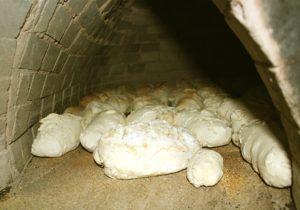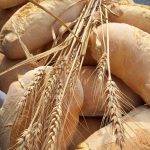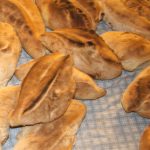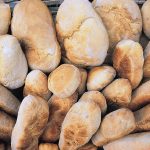
Name
Typical Bread Varieties: Tupunin, Mica of Cuneo, Campagnola Buschese and Rubatà
Seal of quality
Typical Food Farming Product (PAT).
Description
Bread which formed a dietary staple in past centuries is a typical and traditional foodstuff, and it also represents a precious gastronomic heritage to be re-discovered and valued. Traditional bread types differ in shape and size, but they all are made using basic ingredients such as water, wheat flour, salt, natural yeast or (“alvà”). Natural leavening is the result of the spontaneous fermentation of water and flour as the result of a complex micro-flora development, as well as the result of the use of Saccaromyces cervisiae,the leavening agent in beer yeast, and which contains lactic bacteria such as lactobacilli and streptococci. This microbe complex that feeds on the sugars present in the flour generates carbon dioxide which coming against the opposition of gluten (a protein structure which gives the flour their elasticity) causes the mixture to expand. As well as the gas developed in the natural fermentation process, other substances are formed which gives the mixture a certain degree of acidity with acids such as ethanol, acetic acid, lactic acid, , diacetyl and acetaldehyde.
Bread making using solely natural yeast involves the preparation of an initial evening dough using 0.5 kg f natural yeast, 2.5 kg of flour and 1.3 kg of water, after 8 hours a first refreshment procedure is undertaken adding 5 kg of flour and 2.5 kg of water. Further refreshment operations are undertaken at intervals of 3 – 4 hours with the addition of flour and water until the required amount of dough is obtained. Salt is added only to the last dough mixture. Before the second refreshment stage a portion of the dough is removed which will be used as the base dough and which will then be preserved until the next bread making session. During conservation it is important to keep the alvà alive with regular dough re-kneading operations with the addition of flour and water. Once the final dough has been obtained the dough is separated into dough strips of 10-12 kg that are folded over and then cut. The cutting stage gives the dough its typical shape and size and then baked in the oven for 30 -45 minutes at a temperature 250 – 270 °C.
This type of bread making procedure requires very long leavening times as compared to procedures that make use of beer yeast which reduces the leavening times to only a few hours. However the bread obtained has a totally unique flavour and aroma, and can also be easily conserved as well as being more easily digestible.
- In the case of the tupunin bread rolls triangular cuts are made of small size, they are then placed in the oven with the cut side upwards so that on baking the top of the roll opens out like a flower. After cooking it has a piece weight of 70-100 grams, the crust being golden brown colour and a very fragrant aroma.
- For the loaves a triangular cut is again made but of bigger size, and after cooing they weight between 500-700 g each, the crust being a golden brown with a fragrant flavour and which are called different names such as: “paesane”, “tursun”, “campere”, “muniè”, “liber”.

- The campagnola buschese type bread has a particular elongated shape in the form of a french loaf but with an individual weight of 130-150 g. The shape being obtained as the result of the transversal cut of the dough. The Campagnola loaf being highly popular thanks to its fragrance and form. If cut in the middle it can be used to make “rustia”, that is filled with butter and a little sugar with a misture of cheeses allowed to soak (known as “brus”), or to make the “somà d’ai”, that is obtained by rubbing the garlic on the cut side and seasoning with oil and salt.
- The bread making tradition is also fame for its rubatà, which are breadsticks named after the typical agricultural tool called the “rubat” which means rolled. They are made from the same dough as used for making bread and cut into strips which are rolled using a rolling pin, under the palm of the hand to obtain breadsticks of average length. They are then cooked in a oven from a temperature that is made to decrease from 250° C to 200° C and which, unlike the case of bread, is prolonged to eliminate the entire water content. The product obtained is both light and crumbly, and which is easily digestible as part of the starch is transformed into dextrin and maltose.
Area of production
- Tupunin rolls are produced throughout the entire Province of Cuneo
- Miche loaves are produced throughout the entire province of Cuneo
- The Campagnola buschese loaf: is produced by bakeries of Busca (CN), as well as those of other comunes of Cuneo.
- Rubatà breadsticks are the traditional products of the Mondavi area, as well as other Piedmont zones such as Chieri and Andezeno in the Turin zone.
History
Bread is a staple that conceals and represents centuries of tradition and history. In our grandparents time bread was the staple food to be consumed parsimoniously and even a status symbol. In fact the refinement of the milling art has made it possible to obtain increasingly fine, white flour for the complete removal of the bran. This proved to be the start of the production of white bread, which was considered to be a bread of superior quality or the bread of the rich, as opposed to the traditional production of dark bread based on wholemeal wheat flour or other cereals. Bread has very close ties with the local area, and in fact the traditional bread types of certain areas have developed as the result of the need to use the products that were available in the local area. So that often in mountain areas, which lacked wheat flour, bread was made with pure rye flour mixed with chestnuts.
There is a curious anecdote handed down through the ages on the origin of Rubatà breadsticks. History has it that the future king Vittorio Amedeo II was weak and sickly as he was effected by a chronic stomach complaint that was aggravated by the bread available at the time, which although being the “white” bread of the noble, was badly and undercooked, and made unhealthy due to the lack of any hygienic-sanitary standards of the time. A variety of medical potions and mixtures were totally ineffective, until the court physician, originating from the Lanzo Valley, noticed that he was cured from the same ailments by substituting the semi-raw heavy rolls with a biscuit-light bread” that was light and crunchy. This was how the baker Antonio Brunero came to create the ghersino, a light bread, that was up to a metre long “Ghersino”, giving rise to the name “grissino”, being the shortened version of Ghersa, or Grissia, that is the classic bread roll.



